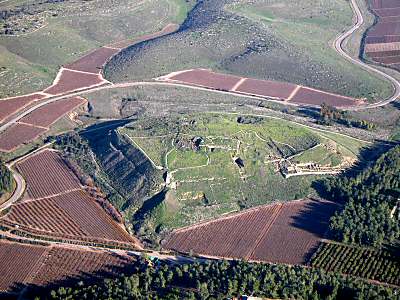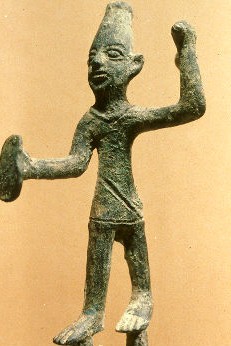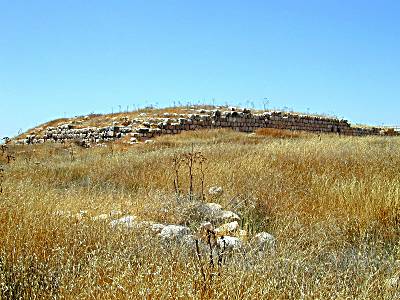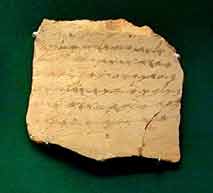

Lachish, is located in the lowlands of the Judean Hills, some 40 km. southeast of Jerusalem. The abundance of water sources and the fertile valleys of the area favored the existence of a prosperous city over a considerable period of time.
 The
Canaanite city of Lachish was established at the beginning of the 2nd
millennium BCE . It was fortified by a wall and a glacis, and
included a large palace, probably the residence of the Canaanite King
of Lachish. From letters sent by the kings of Lachish to their
overlords, the pharaohs of Egypt (the 14th century BCE el-Amarna
correspondence) it may be deducted that Lachish was an important
urban center and the seat of the Egyptian governor of southern
Canaan. This Canaanite city was totally destroyed by fire at the end
of the 12th century BCE. According to one theory, the destruction was
wrought by the Philistines of the nearby Coastal Plain; according to
another, more widely accepted theory, it was wrought by the
Israelites, whose capture and destruction of the city is recorded in
the Bible. (Joshua 10:31,32)
The
Canaanite city of Lachish was established at the beginning of the 2nd
millennium BCE . It was fortified by a wall and a glacis, and
included a large palace, probably the residence of the Canaanite King
of Lachish. From letters sent by the kings of Lachish to their
overlords, the pharaohs of Egypt (the 14th century BCE el-Amarna
correspondence) it may be deducted that Lachish was an important
urban center and the seat of the Egyptian governor of southern
Canaan. This Canaanite city was totally destroyed by fire at the end
of the 12th century BCE. According to one theory, the destruction was
wrought by the Philistines of the nearby Coastal Plain; according to
another, more widely accepted theory, it was wrought by the
Israelites, whose capture and destruction of the city is recorded in
the Bible. (Joshua 10:31,32)
As a rebuilt fortress-city of the Kingdom of Judah, Lachish gained in importance after the split of the kingdom into Judah and Israel. It was the largest city on the western border of the Kingdom of Judah facing the Philistines of the Coastal Plain. A palace-fortress was built on the acropolis and probably served as the residence of the governor appointed by the King of Judah. The Judean city of Lachish was totally destroyed by the Assyrian army during Sennacheribís campaign against the Kingdom of Judah in 701 BCE. The Assyrian campaign, during the reign of King Hezekiah, and the encampment of the Assyrian army at Lachish are described in detail in the Bible. (2 Kings 18:14-17; 2 Chronicles 32:9). During the reign of King Josiah (639-609 BCE), the city of Lachish was rebuilt and fortified. This much poorer city was captured and destroyed by the Babylonian army in 587/6 BCE. (Jeremiah 34:7). In one of the rooms a group of ostraca were found during the excavations in the 1930s. Now known as the Lachish Letters, they constitute an important corpus of Hebrew documents from the First Temple period.(Adapted from the Lachish web site at http://www.israel-mfa.gov.il/facts/hist/arcs2-10.html)
FINDS AT LACHISH
ARTIFACTS
Religious
Buildings and Society
Destruction Levels Baal figurines: In a Canaanite
temple dated to the Late Bronze Age, several small figurines were
found at Lachish. It is widely assumed that these figurines
represent the Canaanite deity Baal.
Baal figurines: In a Canaanite
temple dated to the Late Bronze Age, several small figurines were
found at Lachish. It is widely assumed that these figurines
represent the Canaanite deity Baal.
High Place/Bamah/Matsebot:
A "matsebah" (the plural is "matsebot") is a small raised
stone , sometimes with a carving of praying hands, that is assumed to
represent the deity. They are reminiscent of the stones Joshua sets
up in Joshua 4. They are often found close to a small raised platform
(a "bamah" or "high place") thought to be for burning incense and
other rituals connected with the worship of the local god. In some
places, like the "high place" at Megiddo, animal bones were located
close to or even on the bamah , suggesting that sacrifices took place
there.
like the "high place" at Megiddo, animal bones were located
close to or even on the bamah , suggesting that sacrifices took place
there.
Palaces: In the center of the city was a large palace complex with residential quarters, rows of store rooms, an entrance building and a large open courtyard. This Iron Age palace was unique to Lachish, but may be similar to one of the palaces at Megiddo which was located at the edge of an open courtyard. Several jar handles stamped with royal inscriptions and found in the palace indicate that Lachish may have been a royal administrative center.
Fortification/Gates and Casemate Walls: In the Iron Age II period massive brick walls almost twenty feet thick enclosed the city. An impressive gate system located on the west side provided entrance into the city. Lachish was one of the largest fortified centers in Judah. The gates are similar to, but larger than, the ones at Megiddo, Hazor, and Gezer.
Water system: A water shaft approximately 75 feet wide and 80 feet deep is located on the east side of the tell. This could have been used during Sennacherib's siege of Lachish in 701 BCE to bring water into the city.
 Writing: One of the
most unique discoveries at Lachish are the "Lachish Letters," a
collection of 21 letters painted with ink on broken potsherds. These
letters record correspondence between two military officials dating
to the period of destruction of Lachish by the Babylonians under King
Nebuchadnezzar. An example of one of these letters follows:
Writing: One of the
most unique discoveries at Lachish are the "Lachish Letters," a
collection of 21 letters painted with ink on broken potsherds. These
letters record correspondence between two military officials dating
to the period of destruction of Lachish by the Babylonians under King
Nebuchadnezzar. An example of one of these letters follows:
May YHWH cause my lord to hear this very day tidings of good! .... And let (my lord) know that we are watching for the signals of Lachish, according to all that indications which my lord hath given, for we cannot see Azekah. (Lachish Ostracon IV, ANET., p.322).
Destruction by Egypt: Pharaoh Shishak conquered many Israelite and Judean cities around 918 BCE (see I Kings 14:25f). Although there is no direct evidence that Shishak was in Lachish, several cities in the vicinity were destroyed and it is possible that Lachish was also.
Destruction by Assyrians: Assyrian king Sennacherib and his armies conquered the northern kingdom of Israel in 722 and began to move south into Judah in 701 BCE. This is described in the Bible and on the relief of his palace in Nineveh. The Assyrians built a large ramp on the southwest corner of the city wall which allowed them finally to enter and conquer the city.
The history of Lachish is mentioned in several places in the Bible:
2 Chr 11:7-10 He (Rehoboam) rebuilt Bethlehem, Etam, Tekoa, Beth-zur, Soco, Adullam, Gath, Mareshah, Ziph, Adoraim, Lachish, Azekah, Zorah, Aijalon, Hebron;
2Kgs 18:14 And Hezeki'ah king of Judah sent to the king of Assyria at Lachish, saying, "I have done wrong; withdraw from me; whatever you impose on me I will bear." And the king of Assyria required of Hezeki'ah king of Judah three hundred talents of silver and thirty talents of gold.
2Kgs 18:17 And the king of Assyria sent the Tartan, the Rab'saris, and the Rab'shakeh with a great army from Lachish to King Hezeki'ah at Jerusalem. And they went up and came to Jerusalem. When they arrived, they came and stood by the conduit of the upper pool, which is on the highway to the Fuller's Field.
2Chr 32:9 After this Sennacherib king of Assyria, who was besieging Lachish with all his forces, sent his servants to Jerusalem to Hezeki'ah king of Judah and to all the people of Judah that were in Jerusalem.
Jer 34:7 when the army of the king of Babylon was fighting against Jerusalem and against all the cities of Judah that were left, Lachish and Azekah; for these were the only fortified cities of Judah that remained.
Take me back to the regional map
Take me back to the Assignment Page
